

Voyage to Pandora: First Interstellar Space Flight. Antimatter-Rocket Plan Fuels Hope for "Star Trek" Tech. Positrons cannot be brought into contact with matter, which rules out any storage medium other than a vacuum filled with a magnetic field that contains the particles.

Moreover, positrons carry electric charge and naturally repel each other. So storing just 0.0001 percent of the positrons needed to propel a spaceship to Mars would require containing a million tons of repelling electric force pushing on the walls of the fuel tank. Radical Innovations Several recent discoveries since the late 1990s have altered the picture radically, says Gerald Smith. Smith is a retired professor of physics at Pennsylvania State University in University Park. Last week Smith and his colleagues sent NASA a final report on Positronics' initial investigation into the feasibility of positron-fueled rocketry, which the space agency had partially funded.
The atoms, called positronium, consist of an electron and positron orbiting each other. Antimatter Space Propulsion at Penn State University (LEPS) Humankind has been exploring space for four decades, and in that time our reach has extended throughout the solar system with the use of unmanned probes.
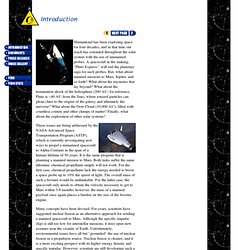
A spacecraft in the making, "Pluto Express," will end the planetary saga for such probes. But, what about manned missions to Mars, Jupiter, and so forth? What about the mysteries that lay beyond? New Antimatter Engine Design. A team of scientists is currently working with NASA to develop a new form of space propulsion technology based on positrons.
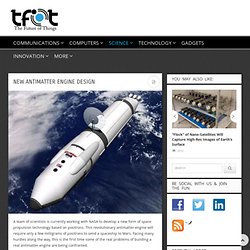
This revolutionary antimatter engine will require only a few milligrams of positrons to send a spaceship to Mars. Facing many hurdles along the way, this is the first time some of the real problems of building a real antimatter engine are being confronted. Space travel has always been mankind’s dream. The 1969 historic moon landing brought the hope that soon we will be able to visit other planets in our solar system, but almost 40 years later this dream is still just that. Reaching Mars will require huge investments in and development of many new technologies. Nuclear propulsion systems for rockets have been studied by NASA since the early 1960′s under the Nuclear Engine for Rocket Vehicle Application (NERVA) program, subsequently cancelled in 1972.
Dr. TFOT recently conducted an interview with Dr. Advantages – Simplicity in design, no obvious technology limits. 24Howe.pdf (application/pdf Object) New and Improved Antimatter Spaceship for Mars Missions. Most self-respecting starships in science fiction stories use antimatter as fuel for a good reason – it’s the most potent fuel known.
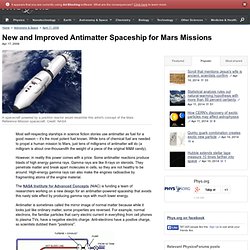
While tons of chemical fuel are needed to propel a human mission to Mars, just tens of milligrams of antimatter will do (a milligram is about one-thousandth the weight of a piece of the original M&M candy). However, in reality this power comes with a price. Some antimatter reactions produce blasts of high energy gamma rays. Gamma rays are like X-rays on steroids. They penetrate matter and break apart molecules in cells, so they are not healthy to be around. The NASA Institute for Advanced Concepts (NIAC) is funding a team of researchers working on a new design for an antimatter-powered spaceship that avoids this nasty side effect by producing gamma rays with much lower energy.
Antimatter is sometimes called the mirror image of normal matter because while it looks just like ordinary matter, some properties are reversed. It will be safer to launch as well. Future Spaceship to have drastic speed with Antimatter. Most self-respecting starships in science fiction stories use antimatter as fuel for a good reason – it’s the most potent fuel known.
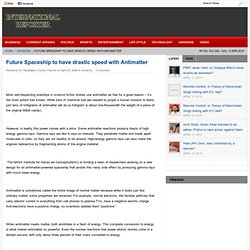
Physicists Strive To Create Atoms Of Antihydrogen From Antimatter. By MALCOLM W.
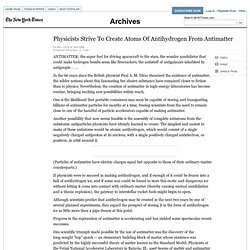
BROWNEPublished: November 15, 1994 ANTIMATTER: the super fuel for driving spacecraft to the stars, the wonder annihilator that could make hydrogen bombs seem like firecrackers, the antistuff of antigalaxies inhabited by antipeople . . .. In the 66 years since the British physicist Paul A. M. Dirac theorized the existence of antimatter, the wilder notions about this fascinating but elusive substance have remained closer to fiction than to physics. When Isaac met Albert (Antimatter may propel future spacecraft to Mars) November 12, 1997: Antimatter is one of the most recognized and attractive words in science fiction.
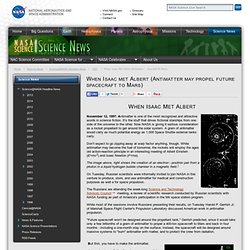
It's the stuff that drives fictional starships from one side of the universe to the other. Now NASA is giving it serious consideration as a rocket propellant to get around the solar system. A gram of antimatter would carry as much potential energy as 1,000 Space Shuttle external tanks carry. Don't expect to go zipping away at warp factor anything, though. While antimatter may become the fuel of tomorrow, the rockets will employ the ages old action-reaction principle in an interesting meeting of Albert Einstein (E=mc2) and Isaac Newton (F=ma). The image above, right shows the creation of an electron - positron pair from a photon in a liquid hydrogen bubble chamber in a magnetic field.1 On Tuesday, Russian scientists were informally invited to join NASA in this venture to produce, store, and use antimatter for medical and construction purposes as well a for space propulsion.